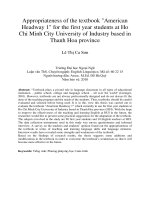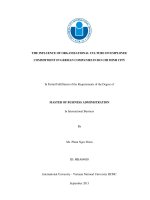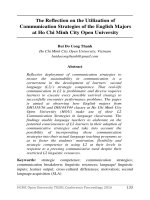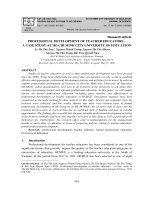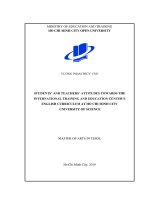effects of mind mapping on freshmen’s reading comprehension ability at ho chi minh city university of transport
Bạn đang xem bản rút gọn của tài liệu. Xem và tải ngay bản đầy đủ của tài liệu tại đây (1.38 MB, 133 trang )
MINISTRY OF EDUCATION AND TRAINING
HO CHI MINH CITY OPEN UNIVERSITY
EFFECTS OF MIND MAPPING ON
FRESHMEN’S READING COMPREHENSION ABILITY
AT HO CHI MINH CITY UNIVERSITY OF TRANSPORT
A thesis submitted in partial fulfillment of the requirements
for the degree of Master of Arts in TESOL
Submitted by: NGO THI PHUONG THAO
Supervisor: Assoc. Prof. Dr. NGUYEN THANH TUNG
HO CHI MINH City
August 2017
STATEMENT OF AUTHORSHIP
I certify that this thesis entitled is “Effects of mind mapping on freshmen’s
reading comprehension ability at Ho Chi Minh city University of Transport is my
original work.
Except where reference is made in the text of the thesis, this thesis does not
contain material published elsewhere or extracted in whole or in part from a thesis by
which I have qualified for or been awarded another degree or diploma.
No other person’s work has been used without due acknowledgement in the
text of the thesis.
This thesis has not previously been submitted for any degree in any other
tertiary institution.
Ho Chi Minh City, 2017
NGO THI PHUONG THAO
i
ACKNOWLEDGEMENTS
First and foremost, I would like to express my sincere appreciation to my
supervisor, Assoc. Prof. Dr. Nguyen Thanh Tung, for his encouragement, dedicated
guidance and valuable comments in the preparation and completion of this study.
Becoming his student is a lucky and grateful opportunity for me in this MA course. He
has offered his precious time to give help and professional advice for my thesis.
Next, I would also like to express my gratitude to my colleagues at the Foreign
Language Faculty of Ho Chi Minh City University of Transport who contributed their
ideas to help my thesis be better and complete. Especially, I would like to give my big
thank to my eighty three dear students who enthusiastically participated in my study.
Then, I am very grateful to all my instructors who have taught me in the
TESOL 8 class with their valuable lessons and supports and my MA classmates at Ho
Chi Minh Open University for their assistance.
Finally, I would like to thank my beloved family who always stand by me to
encourage and give support during my study. I am especially thankful to my beloved
mother for her support and sacrifice for taking care of my newborn boy, and my kind
husband for his help and sympathy so that I could have time to do my thesis.
ii
ABSTRACT
Reading comprehension is one of the most important skills in learning a
foreign language. However, learners face some problems in receiving the information
from a reading text, understanding itdeeply and having the motivation to read it.
Theoretically, mind mapping is a good technique to solve these problems by helping
students comprehend a text easily through colorful visuals and feel interested in doing
comprehension activities. Therefore, this study was conducted to investigate whether
the use of mind mapping had any effects on freshmen’s reading comprehension ability
and theirattitude towardits use after the period of eight weeks.
The study employed the three main data collection instruments of tests,
questionnaire and interview. The data were collected from 83 freshmen of the Faculty
of Mechanical Engineering at Ho Chi Minh City University of Transport for the 20162017 academic year. The independent samples t-test was used for proving that the
disparity between the means of the pre- and post-tests of both groups was statistically
significant, while the questionnaire and interview were used for determining the
students’ attitude.
The findings show that after treatment, the students of the experimental
group made a great progress in their reading comprehension while those of the control
group did not present the remarkable improvement. In addition, most of the students
expressed their positive attitude towards the use of mind mapping in their reading
lessons.
iii
TABLE OF CONTENTS
Page
Statement of authorship ....................................................................................................... i
Acknowledgements ............................................................................................................. ii
Abstract ............................................................................................................................... iii
Table of contents ................................................................................................................ iv
List of abbreviations ........................................................................................................... ix
List of figures....................................................................................................................... x
List of tables ....................................................................................................................... xi
Lists of charts..................................................................................................................... xii
Chapter 1: INTRODUCTION .......................................................................................... 1
1.1. Background of the research ......................................................................................... 1
1.2. Statement of the problem.............................................................................................. 3
1.3. Research aims and questions ........................................................................................ 4
1.4. Significance of the research .......................................................................................... 5
1.5. Organization of the research ........................................................................................ 6
Chapter 2: LITERATURE REVIEW ............................................................................. 8
2.1. Mind mapping overview .............................................................................................. 8
2.2. Types of mind mapping ............................................................................................. 12
2.2.1. Library mind maps............................................................................................ 13
2.2.2. Presentation mind maps ................................................................................... 14
2.2.3. Tunnel timeline mind maps ............................................................................. 15
2.3. Advantages of using mind mapping in reading comprehension lessons .................... 16
2.4. Stages to use mind mapping in teaching reading comprehension .............................. 17
2.4.1. Pre-reading stage ............................................................................................. 18
2.4.2. While-reading stage ......................................................................................... 20
iv
2.4.3. Post-reading stage ............................................................................................. 22
2.5. Mind map figures and how to make a mind map ...................................................... 23
2.5.1. Mind map figures.............................................................................................. 23
2.5.2. How to make a mind map ....................................................................................... 24
2.6. Prior studies on the related topic ................................................................................ 26
2.7. Chapter summary........................................................................................................ 27
CHAPTER 3: METHODOLOGY ................................................................................. 29
3.1. Study setting .............................................................................................................. 29
3.2. Participants ................................................................................................................. 30
3.3. Research design and method of investigation ............................................................ 32
3.3.1. Research design ............................................................................................... 32
3.3.2. Method of investigation ................................................................................... 33
3.3.2.1. Experiment .......................................................................................... 33
3.3.2.1.1. Pre-test ........................................................................................ 34
3.3.2.1.2. Experimental teaching process ................................................... 34
3.3.1.1.3. Post-test ...................................................................................... 36
3.3.2.2. Questionnaire ...................................................................................... 37
3.3.2.3. Interview ............................................................................................. 39
3.4. Analytical framework ................................................................................................. 40
3.4.1. Tests .................................................................................................................. 40
3.4.2. Questionnaire ................................................................................................... 41
3.4.3. Interview ........................................................................................................... 42
3.5. Validity and reliability of the instruments ................................................................. 42
3.5.1. Tests ................................................................................................................. 42
3.5.2. Questionnaire ................................................................................................... 43
3.5.3. Interview ........................................................................................................... 45
v
3.6. Summary .................................................................................................................... 45
CHAPTER 4: DATA ANALYSIS .................................................................................. 45
4.1. Results of the experiment .......................................................................................... 45
4.1.1. Resemblance in the pre-test ............................................................................. 45
4.1.2. Difference in the post-test ................................................................................ 49
4.1.3. Summary ........................................................................................................... 53
4.2. Results of questionnaire ............................................................................................ 53
4.2.1. The students’ awareness of reading comprehension in learning English and
their expectation in improving their reading comprehension ability ............... 54
4.2.2. The students’ reflection on the using of mind mapping in reading
comprehension ................................................................................................. 57
4.2.2.1. The students’ impression on mind mapping ....................................... 57
4.2.2.2. The students’ reflection on the teacher’s application of mind
mapping ............................................................................................................................ 58
4.2.2.2.1. The advantages of mind mapping .............................................. 58
4.2.2.2.1.1. Enhancing students’ motivation ........................................ 58
4.2.2.2.1.2. Stimulating and facilitating the reading comprehension
process ............................................................................... 60
4.2.2.2.1.3. Improving students’ group-work skill and students’
creativity ............................................................................ 65
4.2.2.2.2. The difficulties of mind mapping ............................................... 67
4.2.2.2.3. The frequency of using mind mapping ...................................... 68
4.3. Results from the interview ......................................................................................... 69
4.3.1. Importance of reading comprehension in learning English ............................. 70
4.3.2. Students’ opinion about mind mapping ........................................................... 70
4.3.3. Results and factors affecting the tests ............................................................. 71
4.3.4. Characteristics of mind mapping ..................................................................... 72
vi
4.3.5. Summary .......................................................................................................... 73
4.4. Summary..................................................................................................................... 74
CHAPTER 5: DISCUSSION OF FINDINGS ............................................................... 75
5.1. Students’ performance in pre-test and post-test ........................................................ 75
5.2. Students’ attitude towards the application of mind mapping .................................... 76
5.2.1. Positive aspects ................................................................................................ 77
5.2.2. Negative aspects .............................................................................................. 78
5.3. Summary .................................................................................................................... 80
CHAPTER 6: CONCLUSION AND RECOMMENDATIONS ................................. 81
6.1. Answering the research questions .............................................................................. 81
6.2. Evaluation of the study methodology ......................................................................... 83
6.2.1 Strengths ........................................................................................................... 83
6.2.2 Weaknesses ........................................................................................................ 84
6.3. Recommendations for reading comprehension teaching and learning ...................... 85
6.3.1. For teachers ...................................................................................................... 85
6.3.2. For students ...................................................................................................... 87
6.4. Suggestions for further research ................................................................................. 88
6.5. Summary .................................................................................................................... 88
REFERENCES
APPENDICES
Appendix 1: The typical lesson plan of the experimental group ....................................... 97
Appendix 2: The typical lesson plan of the control group .............................................. 101
Appendix 3: List of students of two groups .................................................................... 103
Appendix 4: Pre-test ....................................................................................................... 106
Appendix 5: Post-test ...................................................................................................... 110
Appendix 6: Questionnaire (Vietnamese version) .......................................................... 114
vii
Appendix 7: Questionnaire (English version) ................................................................ 117
Appendix 8: Interview questions .................................................................................... 120
viii
LIST OF ABBREVIATIONS
CG
Control group
EFL
English as a Foreign Language
EG
The experimental group
HCMCUT
Ho Chi Minh City University of Transport
SD
Standard Deviation
Sig.(2-tailed)
Significance (two-tailed)
SPSS
Statistical Package for the Social Sciences
TESOL
Teaching English to Speakers of Other Languages
TPP
Trans-Pacific Strategic Economic Partnership Agreement
WTO
World Trade Organization
ix
LIST OF FIGURES
Figure 2.3.1: Sample of mind map on the topic of Mind map in the classroom
Figure 2.3.2.1: Model of a library mind map
Figure 2.3.2.2: Model of the presentation mind map
Figure 2.3.2.3: Model of a tunnel timeline mind map
x
LIST OF TABLES
Table 3.2: The information of the control group and the experimental group
Table 3.3.2.1.2: Information of reading text taught to both groups
Table 3.3.2.2: Distribution questions on the questionnaire
Table 3.3.2.3: Distribution questions on the interview
Table 3.5.1: Reliability Statistics of tests
Table 3.5.2: Reliability Statistics of questionnaire
Table 4.1.1.1: Pre-test results for the control group
Table 4.1.1.2: Pre-test results for the experimental group
Table 4.1.1.3: Compare means of the pre-test results of the control group and the
experimental group
Table 4.1.2.1: Post-test results for the control group
Table 4.1.2.2: Post-test results for the experimental group
Table 4.1.2.3: Compare means of the post-test results of the control group and the
experimental group
Table 4.2.2.1a: How students feel about mind mapping
Table 4.2.2.2.1.2b: Students’ responses of the advantage of mind mapping on
facilitating the reading comprehension process
Table 4.2.2.2.2: Students’ responses on difficulties of mind mapping in classroom
xi
LIST OF CHARTS
Chart 4.1.3.1: The changes of means of pre-test and post-test for each group
Chart 4.1.3.2.1: Control group’ distribution of score types
Chart 4.1.3.2.2: The experimental group’ distribution of score types
Chart 4.2.1a: Students’ awareness of importance of reading comprehension
Chart 4.2.1b: Students’ opinion on reading comprehension benefits
Chart 4.2.1c: Students’ self-evaluation of their current reading comprehension ability
Chart 4.2.1d: Students’ desire of the improvement in reading comprehension ability
Chart 4.2.2.1b: Students’ impression on mind mapping
Chart 4.2.2.2.1.1: Students’ responses to the advantages of mind mapping on
enhancing students’ motivation
Chart 4.2.2.2.1.2a: Students’ responses to the advantages of mind mapping on
stimulating the learning process
Chart 4.2.2.2.1.2c: Students’ responses to the advantages of mind mapping on
understanding and memorizing the reading lesson
Chart 4.2.2.2.1.3a: Students’ responses to the advantages of mind mapping on
improving students’ group work skill
Chart 4.2.2.2.1.3b: Students’ responses to the advantages of mind mapping on
improving students’ creativity
Chart 4.2.2.2.3: Students’ responses on the frequency of using of mind mapping
xii
CHAPTER 1
INTRODUCTION
1.1. Background of the study
Vietnam has opened its door to the world in order to welcome international
friends and as a result, Vietnam has quickly been shifting itself for the growth. The
growth of economy in the last ten years has been the most impressive with the
important milestones of its accession to WTO in 2007, the membership of TPP in
2010 and many international economic activities. Therefore, more and more foreign
investors have attracted to Vietnam market and this “has facilitated the economic
development of the country” (Do, 2006, p.3). To maintain this development, it
requires a high quality labor force with good specialist knowledge as well as the
mastery of foreign language skills, especially English because it is an international
language. “English is of great importance for seeking jobs in the domestic labor
market, especially good jobs and jobs in foreign business and joint ventures as well as
a chance to be granted a scholarship” (Phan, 2009, p.178). Thus, more than ever,
learning English becomes imperative and one of the nuclear issues of educational
policy. Particularly, the Vietnamese government has carried out the National Foreign
Language 2020 Project since 2008 in order to improve the Vietnamese people’s
English proficiency.
When working in international business, Vietnamese laborers have to read a
number of foreign materials to upgrade their knowledge; therefore, one of the English
skills that Vietnamese laborers need to master is reading. Reading is one of the
receptive skills that give the main sources of the input for learners (Hasbun, 2006).
-1-
They can learn so many things through reading. Thus, reading is considered as an
essential part in teaching and learning English as well as in every exam. However, it
seems to be more complicated for students to read a text in English as a foreign
language (EFL) because “language comprehension requires knowledge of the world as
well as knowledge of the language” (McNamara &Kitsch, 1996, p.253).
Comprehending a reading text requires “a process of making sense of written ideas
through meaningful interpretation and interaction with language” (Heilman, Blair &
Rupley, 1981, p.242). Therefore, skilled readers need to equip themselves with
suitable strategies to comprehend a reading text. This means that students should be
provided with an appropriate approach to reading comprehension so as to succeed in
language learning (Krashen & Terreil, 1983). Nunan (1999) believes that students
once equipping themselves with an appropriate strategy will improve their reading
skill greatly. As a result, there has been so a lot of research conducted to discover
effective strategies to enhance reading comprehension in Vietnam such as those of KW-L, semantic mapping or extensive reading. Among them, mind mapping occurs as
a preference.
However, a large number of Vietnamese students still have poor reading
comprehension because they face many difficulties in their learning. There have been
a lot of studies conducted in Vietnam to explore the difficulties that students
encounter in comprehending a reading text. Nguyen Thi Thuy Van (2012) states that
students in Ly Thuong Kiet High School in Hai Phong always find it difficult to
understand the context of a reading text and find a main idea. In a study of reading
comprehension problems in English by Ho Van Chung (2013), first year students in
-2-
Hanoi National University of Education (HNUE) prefer giving the answers to
understanding the text deeply. Along with this, Vu Thi Hoang Hoanh (2007) finds the
same problem at Ho Chi Minh City University of Technology (HUTECH). In
addition, the method used to teach reading comprehension at Thu Dau Mot University
in Binh Duong is not an innovation. It “has more or less focused on the product rather
than on the process of learning” (Nguyen Thi Phuoc Binh, 2011, p. 4). This causes
students a lack of motivation. Dinh Thi Huong (2015) states a problem of the
freshmen at Thai Nguyen University: They do not feel excited at the reading lessons
inside class; they try to finish the tasks that the teacher gives without any
encouragement. For these reasons, it is worth drawing attention to reading
comprehension.
1.2. Statement of the problem
In the context of Ho Chi Minh City University of Transport (HCMCUT),
students also encounter the same problem. There are many students who cannot
connect their own knowledge to the new one that they receive from the text and
cannot reorganize the text. Consequently, they think it is very difficult to do reading
comprehension activities and get high achievements. The statistical figures of
HCMCUT Center of Educational Testing Service and Quality Assessment about the
2016 English entrance test result for new students at HCMCUT showed that over 50%
students had enough English proficiency to take an official English course; in this test,
over 65% of the students got under 5 marks for reading comprehension. Moreover, as
reading is one of the important parts in the tests, students seem to prefer to give the
answers to the questions given in the text. They read the text for answering the
-3-
questions only, but not for comprehending it. Therefore, students usually ignore the
meaning of the text and do not read it in depth. In addition, after interviewing
informally some students who were getting obstacles in reading comprehension, the
researcher found that reading teachers at HCMUT were using a conventional
technique by giving students a word list of vocabulary in pre-reading stage, then
giving students a text and asking them to read it within 10 minutes. After that asking
them to answer the questions mentioned in the textbook in while-reading stage and in
post-reading stage, students have to summarize the text by filling in the blanks.
Therefore, students are not interested in the reading activities. As a consequence, they
lack motivation to read.
In summary, there are three main problems that non-English majored
students are facing now. Firstly, students have difficulties in receiving the text
information leading to the low achievements. Secondly, they cannot understand the
text deeply. Finally, they are bored of reading activities.
Considering these facts, the researcher proposes using mind maps as an
alternative technique to teach reading comprehension. Theoretically, mind maps can
help students remember and organize ideas from the text easily through colorful
visuals. Therefore, they can comprehend it and feel interested in doing comprehension
activities so that they can motivationally achieve their reading success. In addition,
practically, there has been a lot of research working on the effects of using mind
mapping to enhance reading comprehension in the world in general and in Vietnam in
particular. Its results assert mind mapping is considered as a successful technique for
improving students’ reading comprehension and for enhancing students’ motivation.
-4-
However, there are still no studies on exploring how students perceive the effects of
mind mapping on their learning process as well as their creativity. For these reasons,
this exploratory study is conducted as an extension to the existing body of knowledge
about mind mapping in some studies in Vietnam.
1.3.
Research aim and questions
This study aims at investigating whether the use of mind mapping has any
effects on students’ reading comprehension and their attitude toward its use.
To achieve the aim as articulated above, the study addresses the two
research questions as follows:
1) What is the effect of the use of mind mapping on students’ reading
comprehension ability?
2) What is their attitude towards its use in reading comprehension?
2.1) How do students perceive the effects of mind mapping on their
motivation, learning process, group work skill and creativity?
2.2) What are, if any, some problems of using mind mapping in reading
comprehension lessons?
1.4. Significance of the research
The research wishes to contribute itself to both theoretical and practical
aspects as presented below.
Theoretically, by applying mind mapping in reading comprehension, the
researcher contributes to the current requirement of English language learners in
exploring the strategies to enhance their learning of reading comprehension. By
examining the use of mind mapping in an academic setting, she hopefully can add
-5-
more useful knowledge about the advantages of mind mapping in dealing with reading
comprehension.
Practically, the findings of this research are expected to help the writer
herself in teaching English reading comprehension. Besides, they can help English
teachers have a useful technique to stimulate their students in reading comprehension
by using mind mapping. Finally, students can find reading comprehension interesting
through mind maps; hence, they are motivated to read more and improve their reading
ability.
1.5. Organization of the research
The research is composed of 6 chapters.
Chapter 1 introduces the topic of the research with background of the study,
statement of the problem, research aim and questions, significance and organization of
the research. Chapter 2 reviews the relevant literature which includes the theoretical
issues of mind mapping with an overview, three basic types of a mind map,
advantages of mind mapping in reading comprehension lessons, its features, steps to
make it and ends with previous related studies. Chapter 3 justifies the research design
and methods to collect the data in this research by describing the study setting,
participants, three main data collection instruments, analytical framework, and the
issues of validity and reliability. Chapter 4 analyzes the collected data from tests,
questionnaire and interview. Chapter 5discusses the findings of the study in terms of
the students’ reading ability and their attitude towards the treatment with mind
mapping. Chapter 6 withdraws the conclusion for the research by answering the
-6-
research questions, proposing some recommendations for teaching and learning
reading comprehension, evaluating the methodology of the study, and suggesting
some topics for further research.
-7-
CHAPTER 2
LITERATURE REVIEW
This chapter shapes a theoretical framework of the study. It begins with the
concept of mind mapping, then three basic types of a mind map, stages to use mind
mapping and advantages of mind mapping in reading comprehension lessons. It ends
with the assertion of its features and figures out the steps to make a mind map and a
review of some previous studies in teaching reading comprehension through a mind
map.
2.1.
Mind mapping overview
Mind map was invented in 1970 by a mathematician, psychologist and brain
researcher –Tony Buzan.
In the early stages, it was known as a concept in
development of thought-radiant thinking. Radiant thinking is considered as the theory
behind mind mapping. Buzan (1993) describes that radiant thinking is a machine of
mind which radiates from a central image with a number of branches away. When the
brain receives bit of information such as feeling, perception, thought, it represents the
information as a central area which radiates never ending hooks, each of which
represents a relationship and each relationship contains its own links and connections
(Buzan & Buzan, 2004).Furthermore, Buzan states that instead of linear structures,
our brain tends to map the information by using data that the brain possesses to make
patterns and organizing them using radiant. Therefore, using mind map helps our brain
receive information, process it, enhance memory, concentrate and create ideas as a
natural function of the brain.
-8-
The process of developing a mind mapping technique was reported by Buzan
(1993) that he tried to use mind mapping primarily for memory. However, over
months of the debate, he was persuaded that creative thinking was also an important
application of this technique. He promoted this technique to the world and since 1990,
the term “mind maps” has been the trademark of the Buzan Organization.
Jonassen, Beissner, and Yacci (1993) define mind maps as “representation of
concept and their interrelationship that are intended to represent the knowledge
structures that humans store in their minds” (p. 16). It could be free to style a mind
map and make the relationship visual. Therefore, students are able to understand a
written text simply.
Budd (2004) describes a mind map as “a graphic organizer in which the major
categories radiate from a central image and fewer categories are portrayed as branches
of larger branches” (p.35). Buzan (2004) chooses another way to define a mind map
by stating that
“A mind map is a colorful, visual form of note-taking that can be
worked on by one person or a team of people. At its heart is a central idea
or image. This is then explored by means of branches representing main
ideas, which all connect to this central idea.” (p.25)
Buzan (2006) continues to expand the definition of mind map by stating more
characteristics. A mind map is a diagram that is used to organize ideas and represent
words, tasks, or other links in which the central keyword is portrayed by branches and
typically it contains words, colors, short phrases, and pictures. Mind maps can be used
-9-
to generate ideas, take notes, develop concept and ideas and improve memory (Buzan,
2000, as cited in Nguyen, 2010). In addition, McGriff (2000) and Edward (2011)
believe that mind mapping can balance the brain, help to organize thoughts, and
improve the creativity and speed of learning.
Kaufman(2008)states that “A mind map is a non-linear diagram that makes it
easy to capture key thoughts and connections between ideas in a graphical / visual
format”(p.5). It means that the idea or concept will be started in the center to help
readers easily connect the thoughts and capture the information. Then the branches
which capture more detailed information related to the key concepts or ideas radiate
away from the thoughts in the center.
Figure 1: Mind map on the topic of Mind map in the classroom (Krasnic, 2012)
Based on these definitions, it can be concluded that “a mind map is a creative
way to represent idea or information through diagram” (Indrayani, 2014, p.16).
A mind map is a diagram while mind mapping is a technique; therefore, there
are different ways to define mind mapping.
- 10 -
Mento, Martinelli and Jones (1999) state that mind mapping is a technique
which enhances creativity and promotes individuals’ learning. They assure individuals
to recall knowledge and to show the relations between different thoughts and
concepts. So, mind mapping can help teachers get feedback about the development of
students’ mental structure. It can help students recall their own knowledge and recycle
them through the use of visual elements. Mind mapping can also be used as a learning
activity in a lesson in which students engage themselves in.
It is also quoted by Brown (2001) that mind mapping is a technique used as “a
specific activity implemented in the classroom that were consistent with a method and
therefore were in harmony with an approach as well” (p.14). While Sugiarto (2004)
defines mind mapping as “a technique to summarize reading resources and then
visualize the problems in the form of map to make it easier to comprehend”(p.11). The
students can use mind mapping to quickly determine the information from the reading
texts, and grasp the organization of a subject and the way the ideas link together. They
can also make notes from the reading recourses clear in order to then report them in a
map which uses colors, symbols or pictures to link the pieces of information to
complete the whole text.
Potter and Hernacki (2004) mention the power of the brain when they define
mind mapping. They state that the mind mapping is a technique to use the whole brain
by using visual and other graphic to create a meaningful impression. Using mind
mapping means using both sides of the brain; hence, the users can maximize the
power of the brain to produce the meaningful things.
- 11 -
2.2. Types of mind mapping
Duffill (2004) states “although this might seem at odds with the divergent
thinking and creativity that characterizes mind maps, it is important when sharing
maps with others that they understand what you are trying to achieve”(p. 1) .
Therefore, it is necessary to determine the basic types of mind mapping. Mind
mapping can take a lot of forms depending on the purposes that the users would like to
capture. However, three basic types of mind mapping are taken into consideration
because of their popularity in life and especially in reading texts.
2.2.1. Library mind maps
Library mind maps can also be known as “reference maps”. They are mainly
“used to organize information” visually; hence, it is easy to look through the multiple
pieces of information and get a precise and visual understanding without missing any
topics (Duffill, 2004, p.1). They are also employed to achieve the purposes of
transferring the information and knowledge, storing and sorting the collected
information, comprehending and studying something. The focus of a library map is
the topics; therefore, they are in the center as the core ideas and they direct the subheadings or statement expanded by following the related topics. In order to create a
library map, it had better start with a number of messy ideas, then classify them into
groups with colors and icons and build linkages between these groups to the central
topics in a tree structure. Such a library mind map model can be presented in Figure
2.2.1 below:
- 12 -

